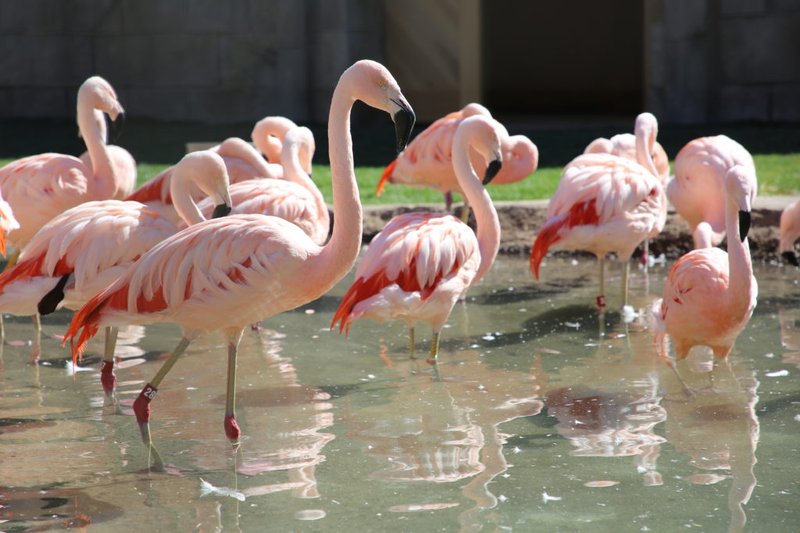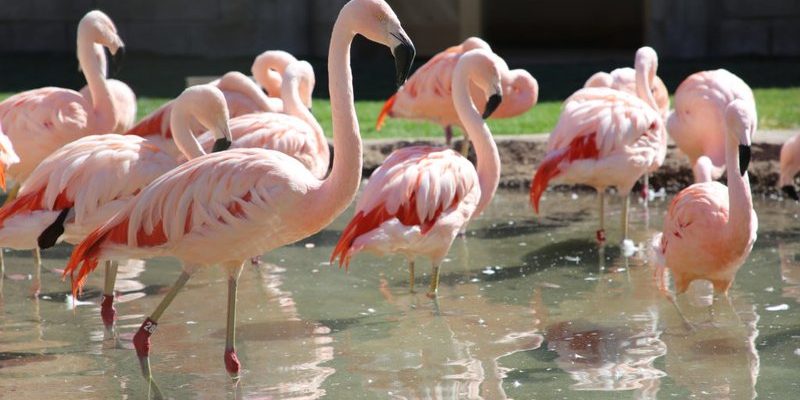
When you think of flamingos, what comes to mind? Perhaps it’s their stunning pink feathers, balancing gracefully on long legs, or maybe that unique way they stand on one leg. Flamingos are fascinating creatures, and they play an important role in their ecosystems. They’re not just beautiful; they’re also vital to the health of their habitats. Understanding these birds goes beyond their stunning looks; it takes us into the heart of their behavior, diet, and the environments they thrive in.
Flamingos belong to a group known as wading birds. They’re primarily found in shallow lakes, lagoons, and estuaries, where they use their distinct beaks to filter food from the water. If you’ve ever watched a flamingo ‘dance’ while feeding, you know how captivating these birds can be. Their vibrant coloration, predominantly due to their diet, adds a splash of beauty to any landscape. So, let’s dive deeper into the world of flamingos!
What Are Flamingos?
Flamingos are large wading birds known for their distinctive pink or reddish plumage and long necks and legs. They belong to the family Phoenicopteridae, with four common species: the American flamingo, greater flamingo, lesser flamingo, and Chilean flamingo. Flamingos have a unique structure in their beaks that allows them to filter-feed on tiny organisms, like algae and crustaceans, from the water. This adaptation is what sets them apart from many other birds and is key to their survival.
You might be surprised to learn that flamingos are not born pink! In fact, they start off as grayish-white chicks. Their vibrant color comes from the carotenoids in the food they consume. It’s a bit like how a carrot turns orange; the more they eat, the pinker they get. Isn’t it amazing how their diet can change their appearance so dramatically? This is just one of the many intriguing facets of these remarkable birds!
Physical Characteristics of Flamingos
Flamingos are hard to miss, with their tall, slender bodies and striking colors. The average height of a flamingo can range from about 3 to 5 feet, depending on the species. Their long legs, which can be almost as long as their bodies, allow them to wade into deeper waters than many other birds can. Flamingos’ bodies are covered in feathers that can vary in shade from pale pink to bright reddish-orange, depending on their species and diet.
Their long necks allow them to reach into the waters while keeping their bodies elevated, making it easier to forage for food. Their unique beaks are specially designed for filtering, featuring a unique lamellar structure. If you’ve ever watched a flamingo feed, you’ll see them dip their heads upside down in the water, using their beaks to sift through the muck to find their favorite snacks. It’s a fascinating process!
Habitat of Flamingos
You’ll typically find flamingos in tropical and subtropical regions of the world. They thrive in shallow waters such as lagoons, mudflats, and salt pans. These environments are rich in the types of food they need and provide safe nesting sites away from many predators. Despite their beauty, flamingos face various challenges, including habitat loss and pollution, which can threaten their populations.
Flamingos are social birds, often seen in large flocks that can range from a few dozen to thousands of individuals. These flocks help provide protection, and they’re often found in colorful displays, creating a mesmerizing sight. They often choose high-salinity or alkaline lagoons, where food is abundant, and competitors are fewer. The stunning landscapes where flamingos reside can be as captivating as the birds themselves!
Diet of Flamingos
When it comes to diet, flamingos are unique eaters. Their primary diet consists of algae, brine flies, and small crustaceans, which are abundant in their watery habitats. These foods are where they get the carotenoids that turn their feathers pink. You might think of flamingos as picky eaters, but they’re actually quite adaptable. They can change their diet based on the available food sources.
Flamingos feed by using their specialized beaks to filter food as they swim. They dip their heads upside down into the water, sucking in sediment and filtering out the food with their tongues. This feeding method is essential for their survival and is a great example of how they’ve adapted to their environments. Isn’t it interesting how such a simple act can have such a vital impact on their health and thriving?
Breeding and Nesting of Flamingos
Flamingos are known for their fascinating courtship displays, which often involve synchronized movements and elaborate dances. These displays can be quite captivating, with flamingos performing ballet-like movements, flapping their wings, and calling to one another. Once paired, flamingos will build nests together—a mound of mud and vegetation—where the female will lay a single egg.
The nesting process is vital for their reproductive success. The mud helps insulate the egg and provides a safe environment, reducing the risk of predation. After about 28 to 32 days, the egg hatches, and the parents share the responsibility of caring for the chick. This nurturing behavior is an essential part of their life cycle, ensuring that the next generation of flamingos can thrive.
Behavior and Social Structure of Flamingos
Flamingos are incredibly social creatures. They live in colonies that can include thousands of birds, and their social interactions are vital to their well-being. These flocks provide safety in numbers and give them a chance to display their unique courtship behaviors. Whether feeding, preening, or resting, flamingos engage with each other, reinforcing social bonds.
Within these colonies, flamingos exhibit a pecking order that helps maintain harmony. You might notice that some birds seem to dominate the feeding areas or nesting sites. This social structure helps reduce conflicts and ensures that all members of the flock can thrive. Observing their interactions can reveal a lot about their personalities and unique social dynamics!
Conservation Status of Flamingos
Flamingos face several threats in the wild, from habitat loss due to development and pollution to climate change affecting their breeding sites. Conservation efforts are essential to protect these stunning birds and their habitats. Various organizations are working to ensure that flamingos continue to thrive in their natural environments. Initiatives include protecting wetlands, regulating hunting, and raising awareness about the importance of flamingos in their ecosystems.
As a responsible member of the global community, you might also wonder how you can help. Supporting local conservation efforts, reducing waste, and spreading awareness about the challenges flamingos face can make a significant difference. Every small action counts, and together, we can help protect these incredible birds.
| Characteristic | Details |
| Height | 3 to 5 feet |
| Weight | 4 to 8 pounds |
| Wingspan | 3 to 4 feet |
| Color | Pink to reddish |
| Diet | Algae, brine flies, small crustaceans |
| Lifespan | 20 to 30 years in the wild |
| Habitat | Shallow lakes, lagoons, and estuaries |
FAQ
What is the lifespan of a flamingo?
Flamingos can live quite long, with lifespans ranging typically from 20 to 30 years in the wild. However, in captivity, some have been known to live even longer, with proper care and a controlled environment. Factors that can affect their lifespan include diet, habitat quality, and threats from predators or human activity.
Why are flamingos pink?
The pink coloration of flamingos comes from the carotenoids found in their diet, particularly in the algae and crustaceans they consume. When flamingos eat these foods, their bodies process the carotenoids and deposit them in their feathers, skin, and even their milk when feeding chicks. This fascinating process highlights how closely tied their appearance is to their feeding habits.
Do flamingos migrate?
Some species of flamingos do migrate, while others are more sedentary. The American flamingo, for example, may move between breeding and feeding grounds, particularly following food availability and water levels. Migration patterns can vary depending on climate conditions and local ecosystems, showcasing their adaptability.
How do flamingos communicate?
Flamingos communicate through a variety of vocalizations, body language, and displays. Their calls can range from honks and grunts to more complex sounds. They also use their posture and movements during courtship to convey messages to each other. Social interactions within flocks are vital for maintaining their bonds and hierarchy.
Are flamingos endangered?
While some species of flamingos are more threatened than others, habitat loss and climate change pose significant risks. For example, the lesser flamingo is considered near threatened due to declining breeding sites. Conservation efforts are key to helping protect these beautiful birds and ensuring their survival for future generations.
What do flamingos do in the winter?
During the winter, flamingos may migrate to warmer areas where food is more abundant. They often seek out shallow lakes and wetlands that provide the necessary conditions for feeding and breeding. Some colonies remain in place year-round, depending on the availability of food and habitat stability.
Can flamingos swim?
Flamingos are indeed capable swimmers! While they primarily wade in shallow waters, they can swim with ease when necessary. Their long legs and unique body structure allow them to navigate both shallow and deeper waters, making them versatile foragers. Swimming is particularly useful for escaping predators or accessing new feeding grounds.
How do flamingos care for their young?
After a flamingo chick hatches, both parents are involved in its care. They feed the chick with a special type of milk produced in their digestive tracts. This ‘milk’ is rich in nutrients and helps the chicks grow quickly. Parents also protect their young from potential threats while teaching them how to feed as they grow, ensuring a strong start in life.

